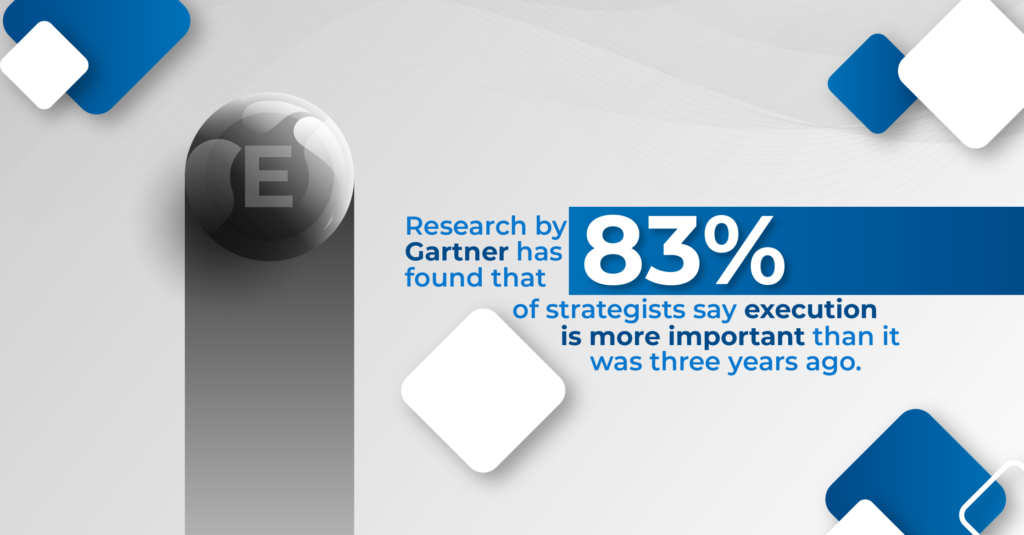
Both are equally vital in disruptive times.
The difficulty of putting a strategy into action is well documented. For decades, researchers and consultants have produced studies on business failure rates and the causes of failure. They have found that it is largely attributable to an inability to execute. As CEOs, we are responsible for translating our organization’s strategic initiatives into action to achieve competitive advantage. However, when the objectives and the anticipated benefits are unclear to stakeholders, execution can turn even the most forward-thinking plan into an insurmountable challenge.
What the Numbers Reveal
Research by Gartner has found that eighty-three percent of strategists say execution is more important than it was three years ago, and two-thirds say they now support execution – whether they review execution action plans, troubleshoot execution problems, coordinate enterprise change or support resource reallocation. Gartner’s research also shows that for maximum impact, we need to pay particular attention to mid-execution support, when guidance from strategists is critical to interpreting and responding to unexpected events.
Over the years, I have observed that many CEOs tend to excel at either strategy or execution, but not both. They divide leaders into two categories: the “visionaries” who embrace strategy and are able to devise ground-breaking ideas; and the “operators”, who play an integral role in implementation. What they do then, is attempt to hire someone that is able to close the strategy-execution gap. But the reality is that it is impossible to separate the two.

Closing the Strategy-Execution Gap
Gartner reports that only 46% of executives and managers agree that their efforts are aligned with strategy. Plus, only 30% of strategists agree that execution efforts are aligned with strategy. The truth is that strategy and execution are both vital leadership responsibilities – neither are somebody else’s job. And closing that gap in our current highly uncertain economic environments can make or break a company’s top and bottom line.
Business is not the same today as it was yesterday – or what it will be tomorrow. That is why a powerful and profoundly relevant business strategy – backed by structured processes – is the number one thing we need in business right now. In a highly disruptive environment, radically improving execution means strengthening action plans, troubleshooting execution difficulties, coordinating change and supporting resource reallocation. This level of disciplined execution can reduce the risk of losing strategic value further down the line.
Putting Structures in Place
As McKinsey’s research points out, “A rigorous approach to the entire business-building process, from initial brainstorming to scaling, is important.” Of the companies that successfully scaled up new businesses, 47 percent reported having clear processes in place for the whole journey, compared with only 25 percent of companies that failed to scale their new businesses successfully.
It’s this approach that enabled Tesla to make such remarkable progress towards its goal of mass-producing affordable electric cars. Tesla knew that batteries would present not only the biggest technological hurdle to its car, but also the biggest obstacle to production. The company took complete control of its supply chain by investing in factories that made batteries. It was an excellent move.
Technology has certainly made it easier than ever to successfully roll out a wide range of business models. At the same time, ongoing innovation and global competitiveness have made differentiation extremely important. That is why we need to focus on honing our abilities to craft powerful business models for the future and to communicate effectively with stakeholders.
A Key Lesson
My personal goal is that our company strategy should always be communicated so clearly, that employees never have to ask “where are we going?”A key lesson I have learned is that it is vital to have a capabilities-driven approach to implementation. This ensures that the people on the ground relate to and understand what they need to do to implement.
In 2022 and beyond, every CEO needs to be equipped with the skills to strategize and execute. The way to do that is to develop the daily structures, systems, and operational goals that set teams up for success. That gives people a plan to get behind and helps with employee retention because everyone across the organization – from workers to management and the board – is committed and aligned to a culture that delivers the best business results.
Originally published on LinkedIn on March 15, 2022.